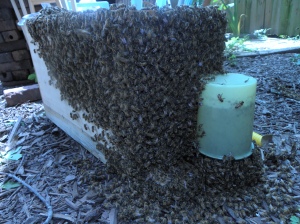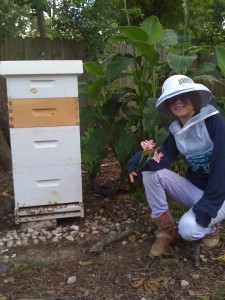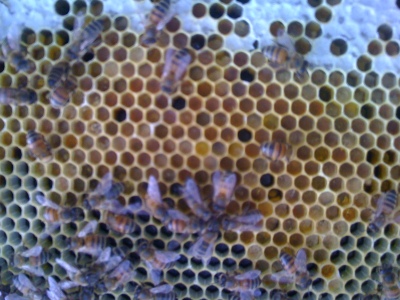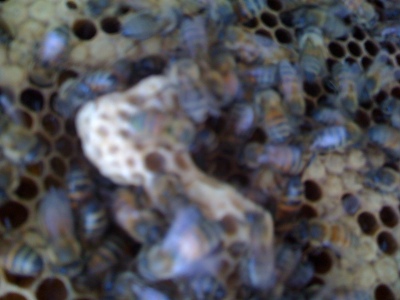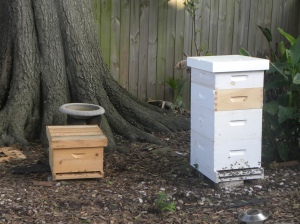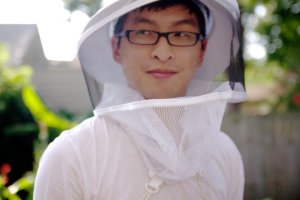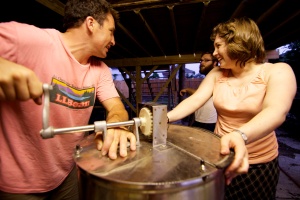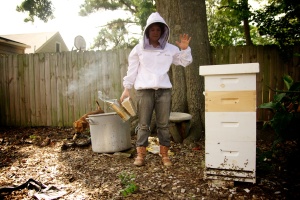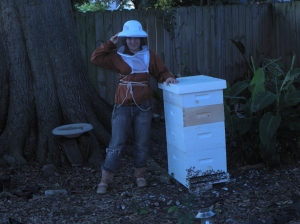This morning I woke up and went to check in on Lili’s fierce bees. Queen Beatrice left us with five stings between us, four for Lili, including one on her face, OUCH. We also robbed two frames of honey from her hive for harvesting.
Then we packed up in the car with the smoker hanging out the window to check on my hives. My swarm hive has undergone a few queen successions. Today, the newly named Queen Hattie, seems to have herself in order. I saw newly laid eggs and a few older brood that were all wrapped up like little worms. There was not any capped brood, but I am confident that in three weeks or so, Hattie will be exploding with bees. Currently, the hive that was quite strong as a swarm has diminished greatly in population. Hattie currently only fills about six of the ten frames. She seems to have a good ratio of honey to brood and has drawn out all of but two of the frames, so I will continue to feed her (sugar water) which will supply the resources to build out the rest of the frames and keep her from starving. However, I am told that there are still plenty of flowering plants even now in Louisiana, so she should be ok.
After the swarm, Queen LaDonna was left with very few bees to support her three box fiefdom. I am not even sure that it is still technically Queen LaDonna’s reign after seeing so many queen cells last inspection after the swarm. Of the 15 or so queen cells that I observed, some were built out of the comb, but many were hanging from the bottom of the frame. I am told that the ones hanging from the bottom of the frame are “swarm cells” where the bees are planning to rear a new queen and then take her with them to a new hive because they are running out of space. The queen cells that are built within the main comb structure are more likely to be supersedure cells, where the bees have identified their queen as too old or not fit to carry on her duties. Since I saw many supersedure cells the week after the swarm, I believe there was unrest among the workers.
After today’s visit to LaDonna, I believe she too has sorted out the drama by either killing the newly reared queen or death by sting. Either way, I observed new eggs laid by the hundreds so LaDonna seems squared away. I robbed two frames from LaDonna but made sure to leave her with enough honey to feed all the new brood. The third box of LaDonna seemed almost empty today, but LaDonna’s numbers are improving. I did receive my second sting from LaDonna today, just toward the end of our inspection on my little pinkie finger of my right hand. Two stings in one day almost doubles my lifetime count. I have now only been stung by a bee 5 times in my lifetime, three as a beekeeper.
Our final inspection was of Queen Delilah, my backyard powerhouse. Delilah forever amazes me. For a hive that was established in early summer, I have robbed her of honey on two occasions, today being the third. Delilah had four boxes, the top two were full of a beautiful bounty. From Delilah I took 14 frames of honey (10 frames per box, four boxes), leaving her with only three boxes and four new frames that are unbuilt. After this, I have no new frames, so the frames that I replace will be drawn out, which is less work for my ladies who are preparing for the winter.
The box of honey that I will extract this weekend weighed approximately 80lbs. So I am guessing I will have at least 60 lbs of honey.
I have already had requests to sell my honey for local friends making mead and honey wine, but I am most excited about selling it to Hollygrove Market, who has requested my honey for their CSA style farmer’s market. Hollygrove has caught on quick to the urban farming scene, and has offered urban farmers of New Orleans a place to sell their surplus. They are committed to purchasing even a pound of surplus garden stock as long as it is LOCAL, and how much more local can you get?
After all this work we settled inside to stare at our collection and Leroy made braised alligator for lunch. I made corn muffins, the perfect vehicle for the sweet nectar of my working ladies.
Speaking of Working Ladies, the name for my swarm hive comes from the famed Hattie Strauss Hamilton, madam of Storyville (the oldtime New Orleans “red light district”). What better name for a queen who reigns over her worker girls? For more about Hattie Hamilton, click here: http://www.storyvilledistrictnola.com/hattie_hamilton.html.





